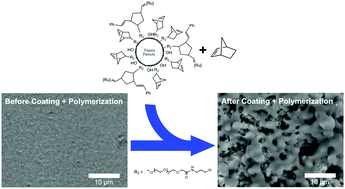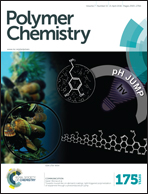The formation and study of poly(ethylene oxide)-poly(norbornene) block-copolymers on the surface of titanium-dioxide particles: a novel approach towards application of si-ROMP to larger surface modification†
Abstract
Ring-opening metathesis polymerization, or ROMP, has been known in the world of polymers as a success story. With its discovery in the middle of the 20th century, the study and understanding of this reaction led to its adoption in a multitude of areas in both academic and industrial domains. However, with the general shift towards hybrid materials and better material integration, surface-initiated polymerization (SIP) has been an area of great interest that ROMP has only tapped into at the very end of the 20th century. With this point in mind, we demonstrate another pathway towards SIP using the si-ROMP approach to form block-copolymers of poly(ethylene-oxide)-poly(norbornene) (PEO-PNB) brushes on particles of titania. In this study, particle modification was first performed and studied, which was then applied towards coating larger, curved tubes to assess their ability for surface modification. In the case of particles, each step was analyzed by XPS to ensure that the expected elements appeared. TGA was then implemented to determine the general grafting density of the PEO chains on the surface, which was found to be 2.7 molecules per nm2. TGA could also determine the degree of polymerization (DP) of the polynorbornene chain, which was 12 500. Finally, SEM was used to image the final products, both film formation using particles, and after use of these particles as a surface coating to cover larger surface areas for surface modification. The functionalized titania particles are determined to be an interesting candidate material for a “seed” layer, which can be used for larger surface modification.


 Please wait while we load your content...
Please wait while we load your content...